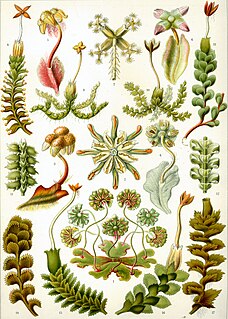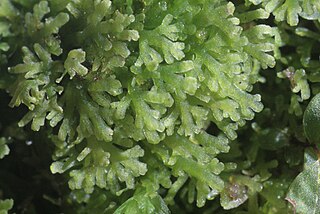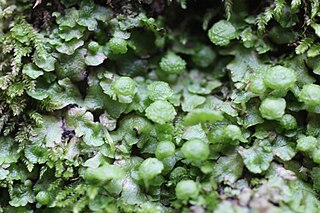
The Marchantiophyta are a division of non-vascular land plants commonly referred to as hepatics or liverworts. Like mosses and hornworts, they have a gametophyte-dominant life cycle, in which cells of the plant carry only a single set of genetic information.

Hornworts are a group of bryophytes constituting the division Anthocerotophyta. The common name refers to the elongated horn-like structure, which is the sporophyte. As in mosses and liverworts, the flattened, green plant body of a hornwort is the gametophyte plant.

Marchantiales is an order of thallose liverworts that includes species like Marchantia polymorpha, a widespread plant often found beside rivers, and Lunularia cruciata, a common and often troublesome weed in moist, temperate gardens and greenhouses.

Metzgeriales is an order of liverworts. The group is sometimes called the simple thalloid liverworts: "thalloid" because the members lack structures resembling stems or leaves, and "simple" because their tissues are thin and relatively undifferentiated. All species in the order have a small gametophyte stage and a smaller, relatively short-lived, spore-bearing stage. Although these plants are almost entirely restricted to regions with high humidity or readily available moisture, the group as a whole is widely distributed, and occurs on every continent except Antarctica.
Monoicous plants are those species that bear both sperm and eggs on the same gametophyte. Dioicous plants are those that have gametophytes that produce only sperm or eggs but never both. The terms are used largely but not exclusively in the context of bryophytes. Both monoicous and dioicous gametophytes produce gametes in gametangia by mitosis rather than meiosis, so that sperm and eggs are genetically identical with their parent gametophyte. The states of being monoicous or dioicous are called monoicy and dioicy respectively.

Cavicularia densa is the only species in the liverwort genus Cavicularia. The species was first described in 1897 by Franz Stephani, and is endemic to Japan, where it grows on fine moist soil.
Pallaviciniaceae is a widely distributed family of liverworts in the order Pallaviciniales. All species are thallose, typically organized as a thick central costa (midvein), each side with a broad wing of tissue one cell in thickness. All species are dioicous. The greatest diversity is in Australasia, with some species endemic to that region, though species belonging to the family may be found on every continent except Antarctica.

Haplomitriopsida is a newly recognized class of liverworts comprising fifteen species in three genera. Recent cladistic analyses of nuclear, mitochondrial, and plastid gene sequences place this monophyletic group as the basal sister group to all other liverworts. The group thus provides a unique insight into the early evolution of liverworts in particular and of land plants in general.

Marchantia polymorpha, sometimes known as the common liverwort or umbrella liverwort, is a large liverwort with a wide distribution around the world. It is variable in appearance and has several subspecies. It is dioicous, having separate male and female plants.

Pellia epiphylla is a species of thallose liverwort. It occurs in North America, Europe, North Africa and parts of Asia. It grows in patches in damp, sheltered places on neutral or acidic substrates. It is common on the banks of rivers, streams and ditches and also grows in wet woodland, marshes and on wet rocks.

Ptilidium is a genus of liverwort, and is the only genus in family Ptilidiaceae. It includes only three species: Ptilidium californicum, Ptilidium ciliare, and Ptilidium pulcherrimum. The genus is distributed throughout the arctic and subarctic, with disjunct populations in New Zealand and Tierra del Fuego. Molecular analysis suggests that the genus has few close relatives and diverged from other leafy liverworts early in their evolution.
Petalophyllaceae is a family of liverworts in the order Fossombroniales. Most species are thallose; that is, the plant is not differentiated into root, stem, and leaf. The thallus is typically small and bears lamellae on its dorsal surface that give it a ruffled, leafy appearance.
Petalophyllum ralfsii, the petalwort, is a liverwort of the order Fossombroniales. It is a small green bryophyte that occurs in the Mediterranean region as far east as Turkey, and along the Atlantic coast of Europe as far as northwest Scotland. It grows primarily on moist sand dunes.

Marchantia berteroana is a liverwort species in the genus Marchantia.
Petalophyllum, or petalwort, is a genus of liverworts in the order Fossombroniales.
Petalophyllum americanum, common name petalwort, is a species of liverwort in the order Fossombroniales. It is endemic to the Gulf Coast of the United States in Arkansas, Louisiana, Mississippi, and Texas. It was first described as the European species Petalophyllum ralfsii in 1919, but a detailed study later showed that the North American form is a distinct species.

Ricciocarpos natans is the only species in the genus Ricciocarpos, a genus of liverworts in the family Ricciaceae. It was formerly listed in 1759 as a species of Riccia by Linnaeus, but then assigned to a new genus of its own in 1829 by August Carl Joseph Corda.

Asterella californica is a complex thallic liverwort in the phylum Marchantiophyta. A. californica often grows as colonies of flat rosettes of light green, rigid thalli, with undersides dark wine-red to nearly black. The receptacles are rounded, with four lobes each bearing a single sporangium sheathed by a white tattered skirt. A. californica is dioecious with separate male plants often intermingled with female plants. This species is found throughout California from San Francisco southward to San Diego and Guadalupe Island. Asterella californica is the commonest species of the three species of Asterella occurring in California; the other two species are A. bolanderi and A. palmeri.

Cryptomitrium tenerum is a species of liverwort native to North America. It is the only representative of its genus on the continent.

Andreaea rupestris is a species of moss in the class Andreaeopsida, are commonly referred to as the "lantern mosses" due to the appearance of their dehisced sporangia. It is typically found on smooth, acidic, exposed rock in the Northern hemisphere. It exhibits the common features of the genus Andreaea such as being acrocarpous, having dark pigmentation, lacking a seta, and bearing 4 lines of dehiscence in its mature sporangia, but can be further identified upon careful examination of its gametophytic leaves which have an ovate base to a more blunt apex compared to other similar species.













